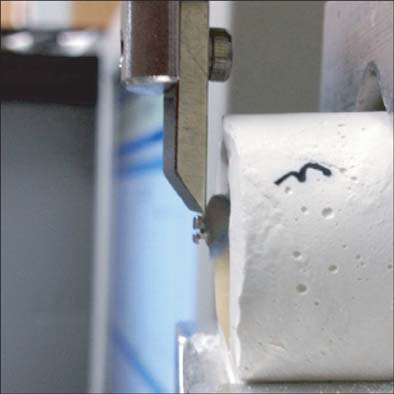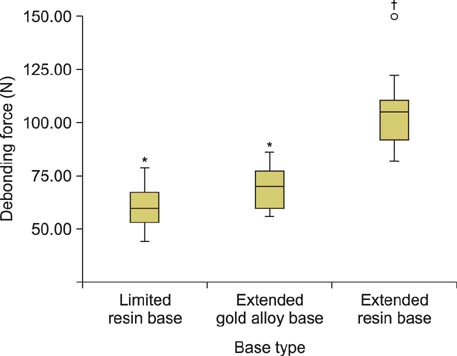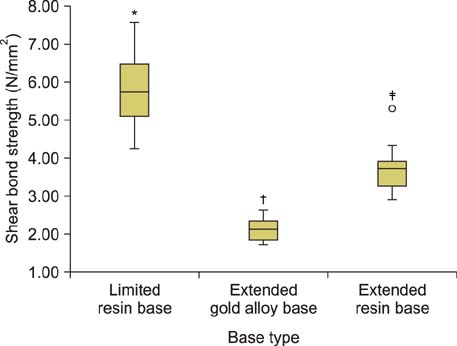Korean J Orthod.
2013 Oct;43(5):235-241. 10.4041/kjod.2013.43.5.235.
Debonding forces of three different customized bases of a lingual bracket system
- Affiliations
-
- 1Department of Orthodontics, School of Dentistry, Kyungpook National University, Daegu, Korea. hmkyung@knu.ac.kr
- 2Department of Dental Biomaterials, School of Dentistry, Kyungpook National University, Daegu, Korea.
- KMID: 2273415
- DOI: http://doi.org/10.4041/kjod.2013.43.5.235
Abstract
OBJECTIVE
The purpose of this study was to investigate whether extension of the custom base is necessary for enhancement of bond strength, by comparing the debonding forces and residual adhesives of 3 different lingual bracket systems.
METHODS
A total of 42 extracted upper premolars were randomly divided into 3 groups of 14 each for bonding with brackets having (1) a conventional limited resin custom base; (2) an extended gold alloy custom base: Incognito(TM); and (3) an extended resin custom base: KommonBase(TM). The bonding area was measured by scanning the bracket bases with a 3-dimensional digital scanner. The debonding force was measured with an Instron universal testing machine, which applied an occlusogingival shear force.
RESULTS
The mean debonding forces were 60.83 N (standard deviation [SD] 10.12), 69.29 N (SD 9.59), and 104.35 N (SD17.84) for the limited resin custom base, extended gold alloy custom base, and extended resin custom base, respectively. The debonding force observed with the extended resin custom base was significantly different from that observed with the other bases. In addition, the adhesive remnant index was significantly higher with the extended gold alloy custom base.
CONCLUSIONS
All 3 custom-base lingual brackets can withstand occlusal and orthodontic forces. We conclude that effective bonding of lingual brackets can be obtained without extension of the custom base.
MeSH Terms
Figure
Reference
-
1. Kyung HM. Individual indirect bonding technique (IIBT) using set-up model. Korean J Hist Dent. 1989; 27:73–82.2. Wiechmann D. A new bracket system for lingual orthodontic treatment. Part 1: Theoretical background and development. J Orofac Orthop. 2002; 63:234–245.
Article3. Fillion D. Clinical advantages of the Orapix-straight wire lingual technique. Int Orthod. 2010; 8:125–151.
Article4. Komori A, Fujisawa M, Iguchi S. KommonBase for precise direct bonding of lingual orthodontic brackets. Int Orthod. 2010; 8:14–27.
Article5. Artun J, Bergland S. Clinical trials with crystal growth conditioning as an alternative to acid-etch enamel pretreatment. Am J Orthod. 1984; 85:333–340.
Article6. Finnema KJ, Ozcan M, Post WJ, Ren Y, Dijkstra PU. In-vitro orthodontic bond strength testing: a systematic review and meta-analysis. Am J Orthod Dentofacial Orthop. 2010; 137:615–622.
Article7. Stanford SK, Wozniak WT, Fan PL. The need for standardization of test protocols. Semin Orthod. 1997; 3:206–209.
Article8. Powers JM, Kim HB, Turner DS. Orthodontic adhesives and bond strength testing. Semin Orthod. 1997; 3:147–156.9. Gittner R, Müller-Hartwich R, Jost-Brinkmann PG. Influence of various storage media on shear bond strength and enamel fracture when debonding ceramic brackets: an in vitro study. Semin Orthod. 2010; 16:49–54.
Article10. Park SB, Son WS, Ko CC, García-Godoy F, Park MG, Kim HI, et al. Influence of flowable resins on the shear bond strength of orthodontic brackets. Dent Mater J. 2009; 28:730–734.
Article11. Ryou DB, Park HS, Kim KH, Kwon TY. Use of flowable composites for orthodontic bracket bonding. Angle Orthod. 2008; 78:1105–1109.
Article12. D'Attilio M, Traini T, Di Iorio D, Varvara G, Festa F, Tecco S. Shear bond strength, bond failure, and scanning electron microscopy analysis of a new flowable composite for orthodontic use. Angle Orthod. 2005; 75:410–415.13. Tecco S, Traini T, Caputi S, Festa F, de Luca V, D'Attilio M. A new one-step dental flowable composite for orthodontic use: an in vitro bond strength study. Angle Orthod. 2005; 75:672–677.14. Mavropoulos A, Cattani-Lorente M, Krejci I, Staudt CB. Kinetics of light-cure bracket bonding: power density vs exposure duration. Am J Orthod Dentofacial Orthop. 2008; 134:543–547.
Article15. Silta YT, Dunn WJ, Peters CB. Effect of shorter polymerization times when using the latest generation of light-emitting diodes. Am J Orthod Dentofacial Orthop. 2005; 128:744–748.
Article16. Swanson T, Dunn WJ, Childers DE, Taloumis LJ. Shear bond strength of orthodontic brackets bonded with light-emitting diode curing units at various polymerization times. Am J Orthod Dentofacial Orthop. 2004; 125:337–341.
Article17. Cacciafesta V, Sfondrini MF, Scribante A, Boehme A, Jost-Brinkmann PG. Effect of light-tip distance on the shear bond strengths of composite resin. Angle Orthod. 2005; 75:386–391.18. Sfondrini MF, Cacciafesta V, Scribante A, Boehme A, Jost-Brinkmann PG. Effect of light-tip distance on the shear bond strengths of resin-modified glass ionomer cured with high-intensity halogen, light-emitting diode, and plasma arc lights. Am J Orthod Dentofacial Orthop. 2006; 129:541–546.
Article19. Klocke A, Shi J, Kahl-Nieke B, Bismayer U. Bond strength with custom base indirect bonding techniques. Angle Orthod. 2003; 73:176–180.20. Yi GK, Dunn WJ, Taloumis LJ. Shear bond strength comparison between direct and indirect bonded orthodontic brackets. Am J Orthod Dentofacial Orthop. 2003; 124:577–581.
Article21. Linn BJ, Berzins DW, Dhuru VB, Bradley TG. A comparison of bond strength between direct- and indirect-bonding methods. Angle Orthod. 2006; 76:289–294.22. Reynolds IR. A review of direct orthodontic bonding. Br J Orthod. 1975; 2:171–178.
Article23. Cozza P, Martucci L, De Toffol L, Penco SI. Shear bond strength of metal brackets on enamel. Angle Orthod. 2006; 76:851–856.24. MacColl GA, Rossouw PE, Titley KC, Yamin C. The relationship between bond strength and orthodontic bracket base surface area with conventional and microetched foil-mesh bases. Am J Orthod Dentofacial Orthop. 1998; 113:276–281.
Article25. Wang WN, Li CH, Chou TH, Wang DD, Lin LH, Lin CT. Bond strength of various bracket base designs. Am J Orthod Dentofacial Orthop. 2004; 125:65–70.
Article26. Sharma-Sayal SK, Rossouw PE, Kulkarni GV, Titley KC. The influence of orthodontic bracket base design on shear bond strength. Am J Orthod Dentofacial Orthop. 2003; 124:74–82.
Article27. Eliades T, Brantley WA. The inappropriateness of conventional orthodontic bond strength assessment protocols. Eur J Orthod. 2000; 22:13–23.
Article
- Full Text Links
- Actions
-
Cited
- CITED
-
- Close
- Share
- Similar articles
-
- Histologic changes of pulpal tissue after laser-aided ceramic bracket debonding
- Changes in lip and perioral soft tissue after bracket removal
- Evaluation of frictional forces between orthodontic brackets and archwires
- A study on morphologic characteristics of lingual surface of crown and lingual archform of Korean adult with normal occlusion
- A study of the shear bond strength of metal brackets and ceramic brackets and the condition after debonding





